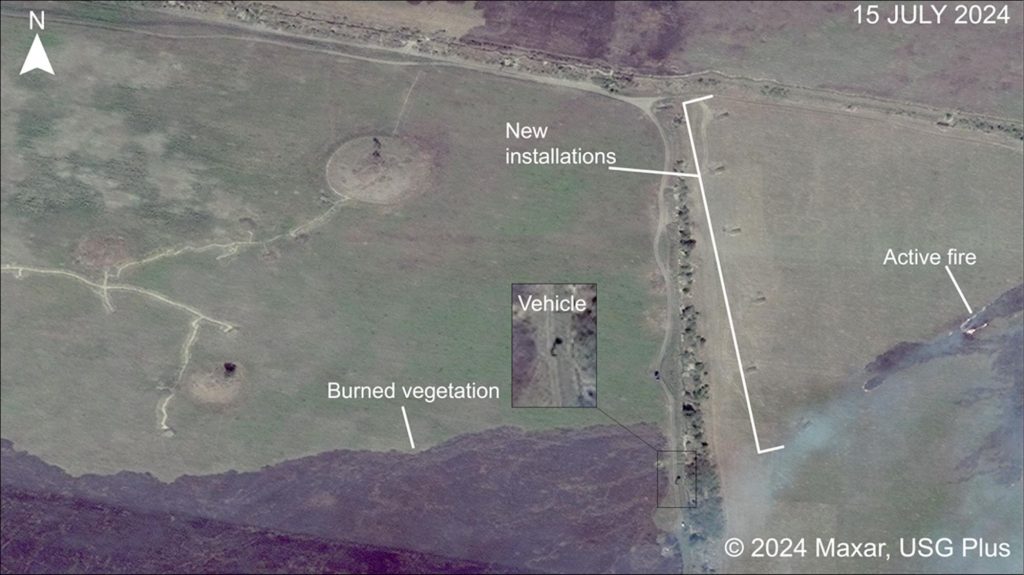
Researchers document Russian destruction of Ukrainian archaeological sites (Image Credit: Phys.org)

As Russian missile strikes and heavy assaults by ground troops pace deadly attacks on Ukraine, a new report by University of Virginia researchers reveals another destructive facet of Russia’s invasion.
Using commercial satellite imagery and other open-source information, associate professor of sociology Fiona Greenland and other researchers with UVA’s Cultural Resilience Informatics and Analysis, or CURIA, Lab determined that multiple ancient Ukrainian burial mounds have been damaged in two locations currently occupied by Russian troops—a potential violation of international law.
These historically significant burial sites, called “kurgans,” were constructed by the ancient peoples of the Ukrainian steppe. The mounds, up to 65 feet tall, contain human remains and artifacts dating back as far as 3000 B.C.E.
Greenland and the other archaeologists and researchers on CURIA’s interdisciplinary team analyzed satellite imagery that they say indicates the kurgans have been disrupted by Russian trench lines, paths and fortifications built on and near the mounds.
Russian Federation armed forces may be using the kurgans to establish advantageous fighting and firing positions, the report asserts. While wartime damage to cultural heritage sites may be expected, damage to the kurgans could be a violation of international law, Greenland said.
The researchers focused on the Zaporizhzhia Oblast region of Ukraine, under the control of Russia’s 429th Motor Rifle Regiment. The report concludes Russian troops may have violated the Hague Convention, an international treaty requiring, among other things, respect for cultural resources during armed conflict.

“Our analysis reveals damage to these sites from military action, but also possible theft or vandalism, which must not be ignored,” she said.
Their report points to the value of satellite imagery, documentation posted online, and other open-source information, in an effort to identify the extent of destruction in dangerous areas where a “boots on the ground” approach to fieldwork is not possible.
“With this report, we’re able to offer insight into what’s happening in occupied Ukraine in areas that Russia has invaded and still controls,” Greenland said.
“We know from eyewitness reports of extensive destruction of cultural sites, archaeological sites, museums, houses of worship and so forth. But documenting these impacts behind the front lines is very difficult, because it’s too dangerous to send people to do this work firsthand.
“We’re able to provide a look at an occupied area, Zaporizhzhia, through satellite imagery,” Greenland continued. “We were able to carefully reconstruct a timeline beginning from before the full-scale invasion through to the arrival of Russian military units in the area and the corresponding impacts they continue to inflict on these ancient burial mounds.”
CURIA Lab archaeologist Kate Harrell said they have reason to believe that the locations examined in their report are not the only examples of damage inflicted upon Ukrainian archaeological sites due to Russian fortification activities.
“There are thousands of burial mounds and, in this report, we only examined two sites in Zaporizhzhia oblast,” Harrell said. “Further documentation needs to take place.”
Christa Acampora, dean of the College and Graduate School of Arts & Sciences, commended the researchers for contributing their valuable expertise.
“The most powerful research overcomes many obstacles to discovery through creative, interdisciplinary efforts,” Acampora said. “This new report by associate professor Greenland and the CURIA Lab exemplifies that makes a difference through its tremendous contributions to the global community. We are truly fortunate to have professor Greenland’s expertise at the University.”
The CURIA Lab is a research partner of the Conflict Observatory. Created in February 2022, the Conflict Observatory supports a consortium of independent, university-based experts who use open-source information to produce high-quality documentation of potential human rights violations and international crimes to increase public awareness and enable accountability.
The CURIA Lab report joins other Conflict Observatory publications that identify, analyze and preserve possible evidence of atrocities that impact Ukrainian people, places, resources and cultural heritage sites.
More information:
Report: Documenting Russian Military Activity in the Vicinity of Ukrainian Archaeological Burial Mounds: Fortification, Destruction, and Possible Looting
Provided by
University of Virginia
Researchers document Russian destruction of Ukrainian archaeological sites (2024, September 19)
retrieved 20 September 2024
from https://phys.org/news/2024-09-document-russian-destruction-ukrainian-archaeological.html
part may be reproduced without the written permission. The content is provided for information purposes only.





